Scientific Name: Stanleya pinnata
Common Name: prince’s plume, desert prince’s plume
Plant Family: Brassicaceae (formerly Cruciferae)/mustard
Text by Janice Tucker
Photos: Al Schneider, Carl Troy, Janice Tucker
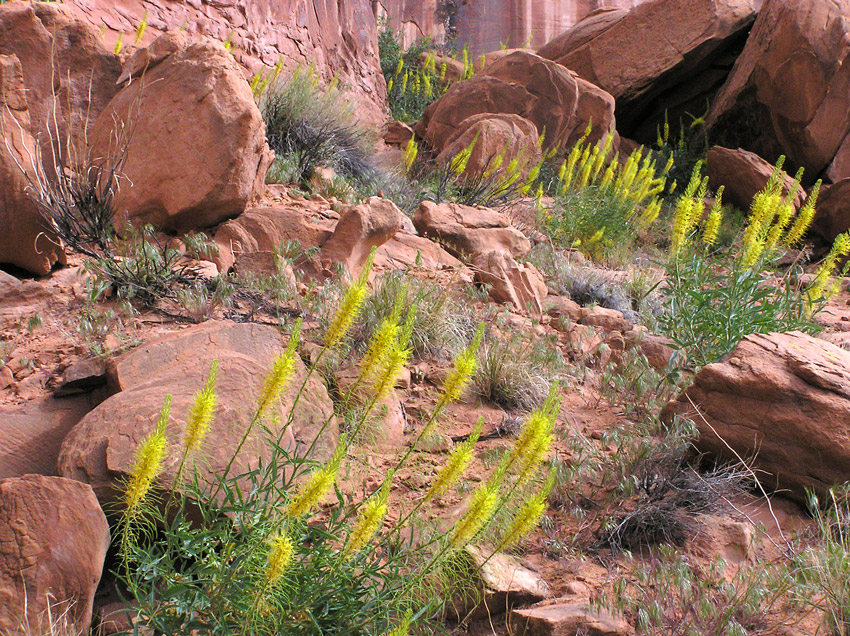
Photo © Al Schneider swcoloradowildflowers.com
Nature is tough. Since the beginning of time flora and fauna have demonstrated a stubborn determination to survive and thrive. While it is easy for us to understand how plants can prosper in lush regions with rich soils and sufficient rainfall, we cannot help but be in awe of the beautiful plants that actually demand almost impossible growing conditions. The Stanleya pinnata, commonly known as prince’s plume, is such a plant. Dramatic yet delicate flowering plumes belie the plant’s tough fortitude by flourishing in the dry, harsh environment of the southwestern United States. Imagine driving along a highway to come upon the somewhat incongruous sight of a rugged, rocky landscape filled with stands of seemingly fragile Stanleya pinnata sporting bright yellow racemes waving in the breeze.
New Mexico lies comfortably in the Stanleya pinnata’s native range that covers the Great Plains and most of the western United States. It thrives in the open areas of grasslands as well as foothills, rocky outcrops and hillsides. Growing naturally in elevations of 3,000 to 9,100 feet, the drought-tolerant Stanleya pinnata prefers alkaline and gypsum soils and will even grow in caliche. It responds with a more vigorous growth and showier flowers -but an unpleasant odor- when there is a large amount of selenium in the soil. Although it greedily absorbs selenium like we would devour ice cream or chocolate, the Stanleya pinnata is not dependent on this element to further its growth.
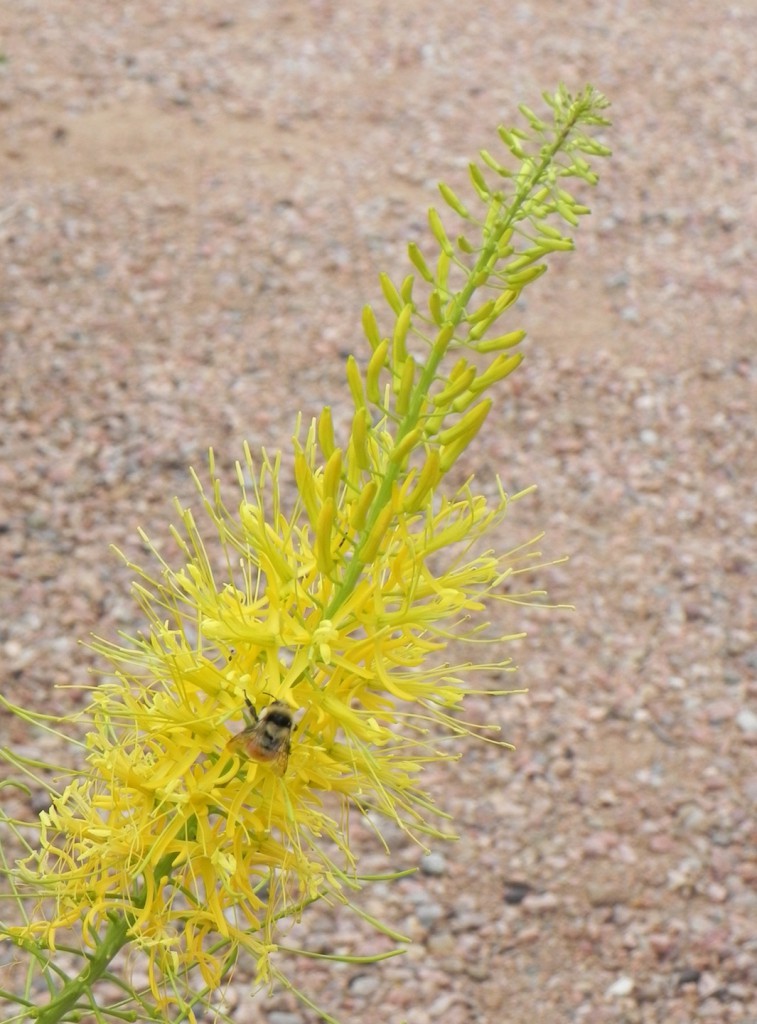
Princes plume in Ojos y Manos (Photo: Carl Troy)
Growing to heights of 2 to 5 feet, the perennial Stanleya pinnata awakens in the spring when pinnately lobed, basal leaves emerge from a woody base followed by tall, light green, unbranched stems. The leaves that ascend the lower portion of the stems become more slender and slightly wavy. In late April through May, and sometimes into early June, the Stanleya pinnata wows us with racemes of densely packed, bright lemon yellow flowers that burst into bloom from the upper two-thirds of the stems. After a flower-starved winter with only houseplants and hothouse floral arrangements to sustain our flower addiction, these springtime graceful plumes are like manna from heaven.
The Stanleya pinnata confirms its credentials as a member of the Brassicaceae/mustard family with a flower composition of 4 petals, 4 sepals, 4 long stamens, 2 short stamens, 1 pistil and a unique seed structure. But it is not an ordinary mustard flower. The Stanleya pinnata asserts its individuality in an elegant, creative arrangement of the flower components that must have been the inspiration for the common name of prince’s plume.
The sepals perform botanical acrobatics as they bend slightly backward toward the stem, calling attention to the more upright petals. The stamens and the pistil create a feathery illusion as they extend beyond the petals to beckon pollinators such as bees, moths and other insects. The culmination of multiple flowers per raceme takes on the appearance of a spectacular, yellow plume. The flowers open from the bottom up, thus prolonging the blooming time. After the bloom the Stanleya pinnata’s attractive translucent seed pods remain on the racemes until they break apart to release tiny, dark, oblong seeds.
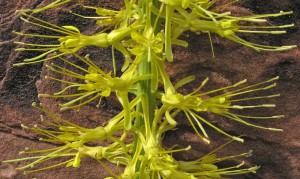
©Al Schneider, www.swcoloradowildflowers.com
The Stanleya pinnata may have been born in the wild but its beauty and adaptability have caught the attention of landscapers who have also designated it as an ornamental for more cultivated settings. Hardy in USDA plant zones 4 to 9 the Stanley pinnata does best when not pampered. Give it full sun, water deeply every other week when temperatures are above 75 degrees F., and once a month in the winter. It prefers infertile soil, and that means to back off from fertilizing. It is great for a spring pick-me-up splash of color in a xeric location. Maintenance is minimal. But there are persnickety gardeners who are anal about aesthetics – and we are legion – who may opt to do the following: Remove yellowing basal leaves as the plant continues to flower and snip off seed pods after they have completed their annual duty of disbursing their tiny treasures. Removing dead stems and pruning the plant close to ground level during autumn or early spring will maintain a tidy appearance and encourage a more vigorous growth. In Santa Fe the Stanleya pinnata is a colorful spring sight in the Ojos y Manos section of the Botanical Garden at Museum Hill. It grows along the pathway in the Sunset Discovery Walk area.
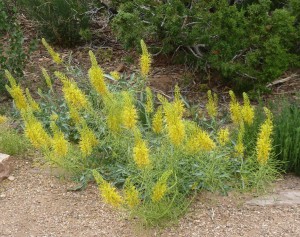
Princes plume growth habit in Ojos y Manos (Photo: Janice Tucker)
Which is the better method for planting the Stanleya pinnata – seeds or potted transplants? The general consensus is that the Stanleya pinnata will become more firmly established and robust when started from seeds. Gently rake seeds into warm, loose soil. This will give the new taproot and lateral roots room to grow. The warm soil works to speed germination which should occur in about 2 weeks. However, for the gardeners who are too impatient to wait for seeds to sprout and grow, transplanting from pots of bedding plants can work too. Dig a hole no deeper than the root ball and 4 times as wide. Water enough to make sure the plant is firmly positioned. Fine gravel mulch helps to keep the soil moist for the new transplant. Watering needs are minimal once the plant is established. Avoid transplanting a Stanleya pinnata that is firmly established in the ground. Once rooted, these plants prefer to bloom where they are planted and can be a bit cranky if disturbed. But why make the decision to seed or transplant from small pots? Do both!
The mustards, whether wild or ornamental, have proven to hold both edible and medicinal merit. There are some naturalists who claim that the entire plant is safe to eat but others warn of toxicity. This is particularly true of mustards that tend to grow in areas where the soil is high in selenium. Ranchers try to avoid allowing their livestock to graze in such areas because of the problems selenium can cause to the animals. Best to err on the side of caution, especially when it comes to uncertainty of soil content. That said, mustards are the base of tasty spreads that enhance sandwiches, salads and entrees. Mustard plants such as radishes, nutritious greens, and dishes prepared with cabbage, broccoli and cauliflower find their way to the dinner table. Horseradish adds a spicy pop to seafood cocktail sauces and is a piquant accompaniment to a juicy steak. It is not surprising that such a pungent plant has a place in folk medicine. Poultices have been prepared from mustard plants to treat a variety of health issues in relieving inflammation and pain. There are more than 350 genera in the Brassicaceae/mustard family. So these examples only scratch the surface of the ways mustards are utilized.
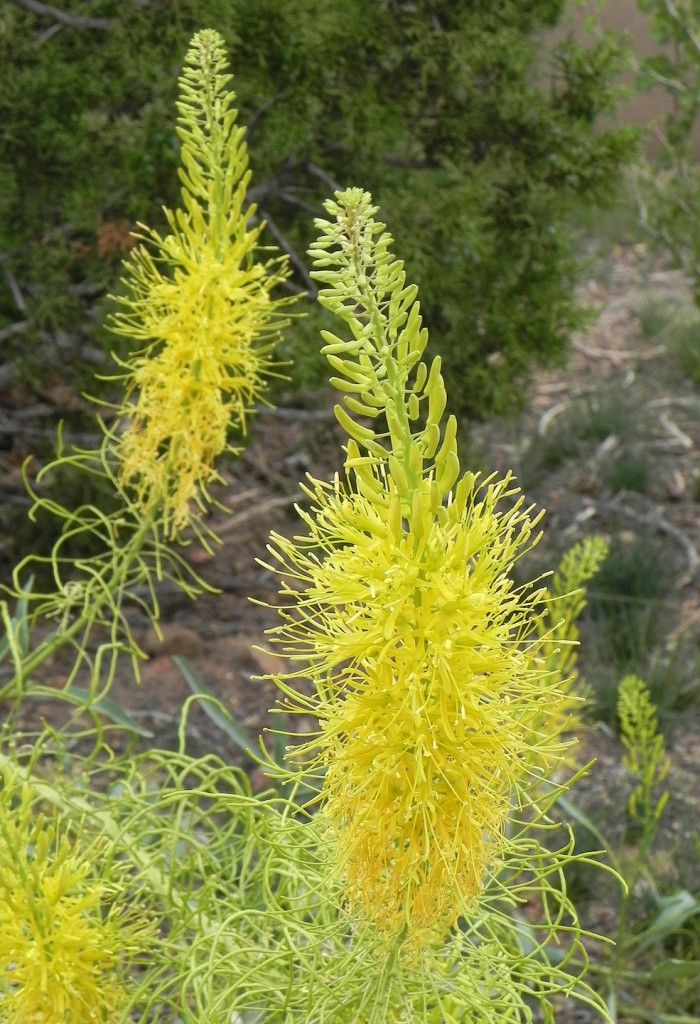
Princes plume (Photo: Carl Troy)
The scientific name of Stanleya pinnata has evolved after many changes over the past 200-plus years. The short version is that the generic name of Stanleya is in honor of British naturalist, Lord Stanley, 13th Early of Derby (1775-1851). The specific name has batted back and forth over the years between pinnata and pinnatifida with the former now the current species. Both specific words refer to the shape of the basal leaves as “feather-like” or “finely cut”. Although the “feather-like” definition denotes the leaf shape, it could also be an apt description of the racemes.
Plume often refers to a bird’s feathers (plumage). That may be. But the Stanleya pinnata is a prince of a plant with vibrant, yellow, flowering plumes that would cause a proud peacock to turn green with envy.
Thanks to Helen Woody and Jeanne Gozigian for proofreading this article.
Sources consulted and/or cited:
Anderson, Richard M.; Gunnell, Jay Dee; Goodspeed, Jerry L., Wildflowers of the Mountain West.
Dave’s Garden website, Botanary glossary.
Elpel, Thomas J., Wildflowers-and-Weeds website, Brassicaceae, Plants of the Mustard Family.
Lady Bird Johnson Wildflower Center Plant Database, Stanleya pinnata.
National Audubon Society, Field guide to Wildflowers, Western Region.
Phillips, Judith, New Mexico Gardener’s Guide.
Pollinator Partnership website, Selecting Plants for Pollinators- A Regional Guide for Farmers, Managers and Gardeners in the Intermountain Semidesert and Desert Province (a pdf document), pollinator.org.
Schneider, Al, Southwest Colorado Wildflowers for Stanleya pinnata content and photographs, www.swcoloradowildflowers.com.
SEINet – Arizona Chapter website, Stanleya pinnata.
Troy, Carl, special thanks for permission to use his beautiful Stanleya pinnata photographs.
National Plant Germplasm System (GRIN) website, Stanleya pinnata (Pursh) Britton.


